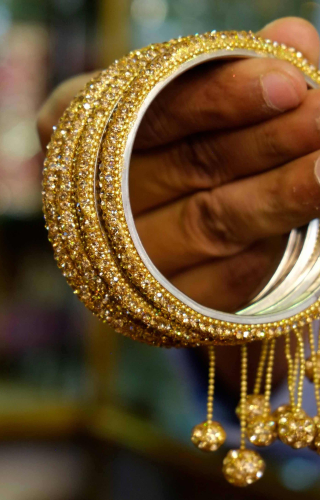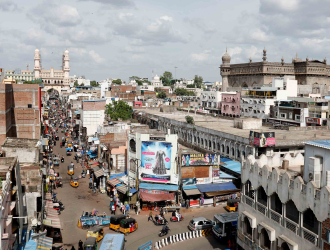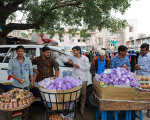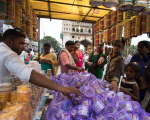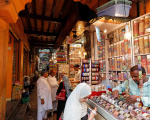I remember, from my childhood, that my mother would wear several colourful glass bangles on her wrists. After my father's demise, she stopped wearing them and instead, put on a single gold bangle. I did not understand the reason then, but later realised that bangles are not just pieces of jewellery worn for adornment—they are symbols of a woman’s marital status. Newly married brides from the Hindu, Sikh and Muslim communities of Hyderabad wear elaborate bangles on their wrists for a few months—often up to a year—after the wedding. These bangles are discarded if the woman is widowed.
Apart from weddings, in Hyderabad and Secunderabad, new bangles are bought during a number of local Hindu festivals like Bonalu Jatara, Medaram Jatara, Edupayala Jatara, Inavolu Jatara, Kothakonda Jataraand Komuravelli Jatara. Another major Hindu festival when new bangles are worn is Bathukamma, which is celebrated during the nine days of Navaratri, ending with Dussehra. Over the years, I have been visiting the local melas during jataras (processions) and festivals, as well as the wholesale market at Laad Bazaar, photographing the thriving bangle culture in these places.
Laad Bazaar is located in the heart of Hyderabad’s old city, which is spread around the iconic Charminar. It is always colourful and bustling with activity, particularly during Ramzan. Laad Bazaar was built by the Qutub Shahis, who founded the city of Hyderabad in the 1590s. A popular story credits the establishment of Laad Bazaar to Sultan Mohammad Quli Qutub Shah, who set it up to provide bridal trousseau for his daughter’s wedding. Even in modern times, the market continues to trade in a variety of items that are a part of the standard wedding trousseau, including bangles, bridal wear and jewellery.
The bangles sold at Laad Bazaar are manufactured locally. They are made in small karkhanas (workshops) tucked away in narrow lanes or attached to the rear of bangle shops. For my documentation work, I got in touch with Jaffarbhai, who works at Khaja’s Bangles Store, established by his grandfather in 1957. Since then, three generations of his family have been involved in the craft of bangle-making. It must be noted that many women and children are employed as manual labourers in this industry, particularly in the Talab Katta area around the Charminar. Because of this, karkhana owners are not always willing to allow outsiders in their premises. Though they were initially hesitant, Jaffarbhai eased up to my presence after my frequent visits, and gave me access to their karkhana. Here, I was able to witness, first-hand, the various techniques and skills involved in bangle-making, as well as the condition of the living spaces of the craftsmen working here.
Most karkhanas are integrated with the craftsmen’s residences, where they live with their extended family, many of whom also receive hands-on training from childhood. This is how the skills and knowledge are passed down through generations in the same family. The hardware and tools needed for the craft are relatively simple and are usually custom-made locally. The raw materials used in the production of bangles are sourced from outside the state. Thankfully, the demand of the bangles has grown over the years, particularly since the 1980s. There are currently around 4,000 craftsmen working in Laad Bazaar market. However, Hyderabad is not the only city which has a legacy of bangle-making in India. They are also produced in Firozabad, Uttar Pradesh, where the industry specialises in the making of glass bangles. Though glass bangles are also made in Hyderabad, the speciality of Laad Bazaar is bangles made of lacquer. In fact, it is believed that Laad Bazaar derives its name from ‘lac’, which is the local word for lacquer.
Lac is a resinous secretion produced by the Kerria lacca insect, and the raw material is sourced from the kusum tree on which the insects are farmed. The lac is purchased from dealers in its raw form and then processed, coloured and worked into various designs using a technique of slow heating. The bangles are then decorated with various glass and bead embellishments.
These finished bangles are then packaged and sold at the shops in Laad Bazaar, where customers can mix and match bangles according to their liking. Surplus bangles are exported to international markets in the United States of America, the United Kingdom, Singapore, Malaysia, and Middle Eastern countries such as the United Arab Emirates, Qatar and Bahrain.
Other than organised wholesale markets like the one at Laad Bazaar, bangles are also sold through the unorganised sector, which is heavily dependent on business during the various melas that take place in Telangana during major Hindu festivals. One such important festival is Bonalu Jatara, which falls in the month of July/August. Mobile vendors and small-traders of bangles congregate at processions around various Hindu temples scattered in Hyderabad, Secunderabad and other regions in Telangana, which are attended by lakhs of people from across the state. On these occasions, women purchase new bangles from the fairs, not only for themselves, but also as offerings to the goddess Mahakali. The bangles are offered along with jaggery and specially cooked rice in an earthen pot adorned with neem leaves and turmeric. This offering is known as bhojanam, from which the festival Bonalu gets its name.
Through my photographs, I have tried to capture the many ways bangles form an integral part of Telangana’s culture, cutting across religious denominations. Be it at weddings, or during Ramzan or Bonalu Jatara, new bangles are worn on most auspicious occasions, and they are worn by all women of the region. The bangle has always been an icon of Hyderabad’s inclusive and syncretic culture.
